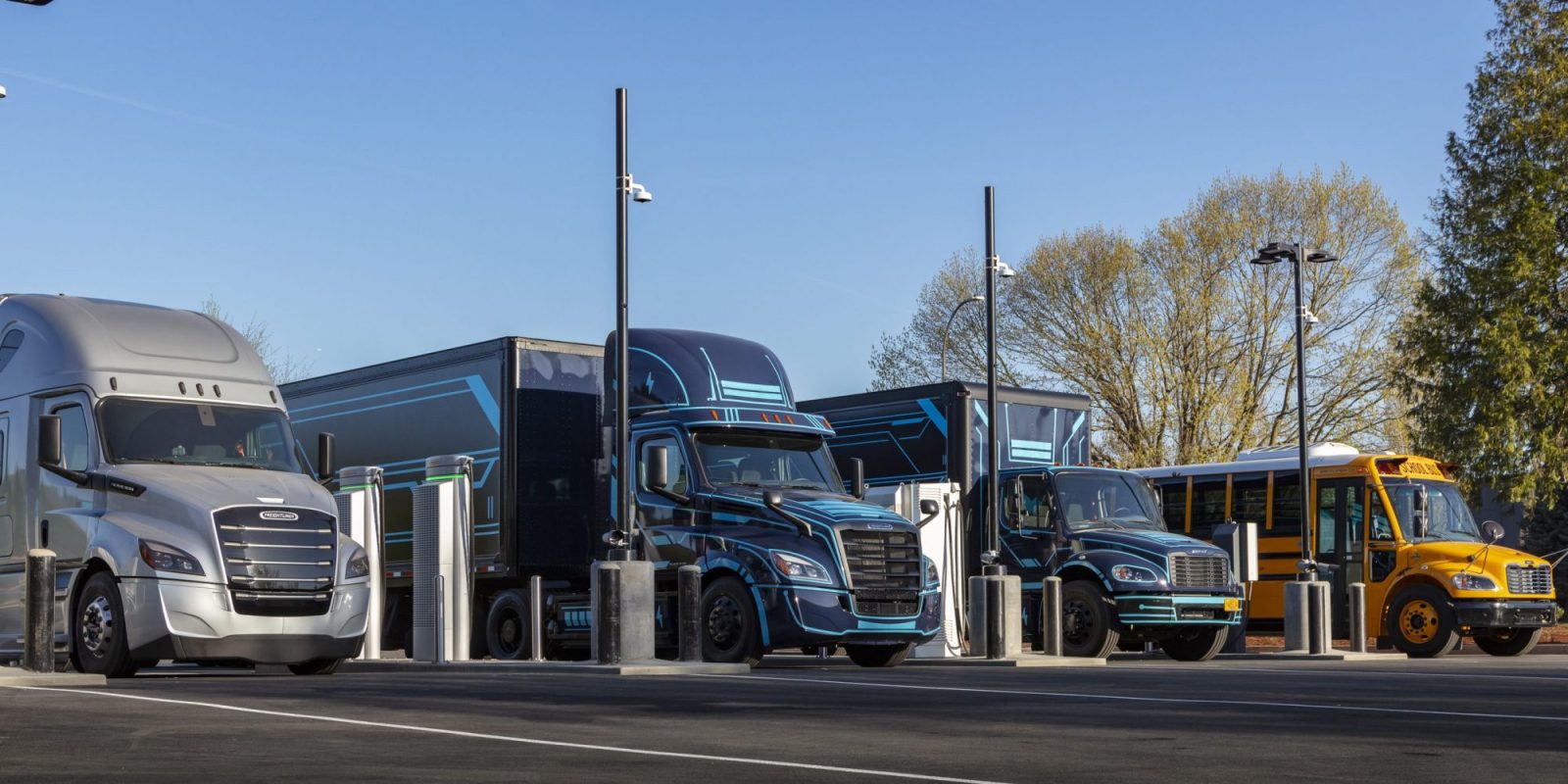
Daimler Trucks North America invited us out for a test drive of all of Daimler’s electric truck portfolio — the Freightliner eCascadia and eM2, the Jouley electric school bus, and a walk-in delivery van on the MT50e platform by Freightliner custom chassis.
Coming away from the experience, we’re more excited than ever about the electric future for these fleet offerings.
The spectrum of vehicles we saw could see a wide variety of usage in delivery applications, spanning the whole gamut of medium- and heavy-duty shipping. The only thing missing, so far, is long-haul trucking, but we even heard some of their future plans that could support that application.
Our test drives were just in circles around a parking lot, though a relatively bumpy one at that. We got a short look at the acceleration, braking, pedal response, ride smoothness, noise, and general user interface for the four vehicles.
eCascadia electric Semi truck first drive
The eCascadia is Daimler’s entry into the class 8 semi-truck market, with a max combined weight of 82,000lbs.
Daimler expects that this truck will largely be used for short-haul applications rather than long-haul. Last mile delivery, drayage, food & beverage, and regional distribution are all on the table. Anything where the truck returns to a depot is a great fit.
Daimler was a little coy about range estimates, which makes sense, given that the truck is available in multiple configurations and range is highly affected by load, environmental conditions, speed, and incline. It comes in 315 or 475kWh configurations, with “up to 250 miles” of range. We got them to say that that range number should be attainable with a 65,000-ish pound gross vehicle weight, which is less than the maximum but still quite heavy. As always, your mileage definitely will vary.
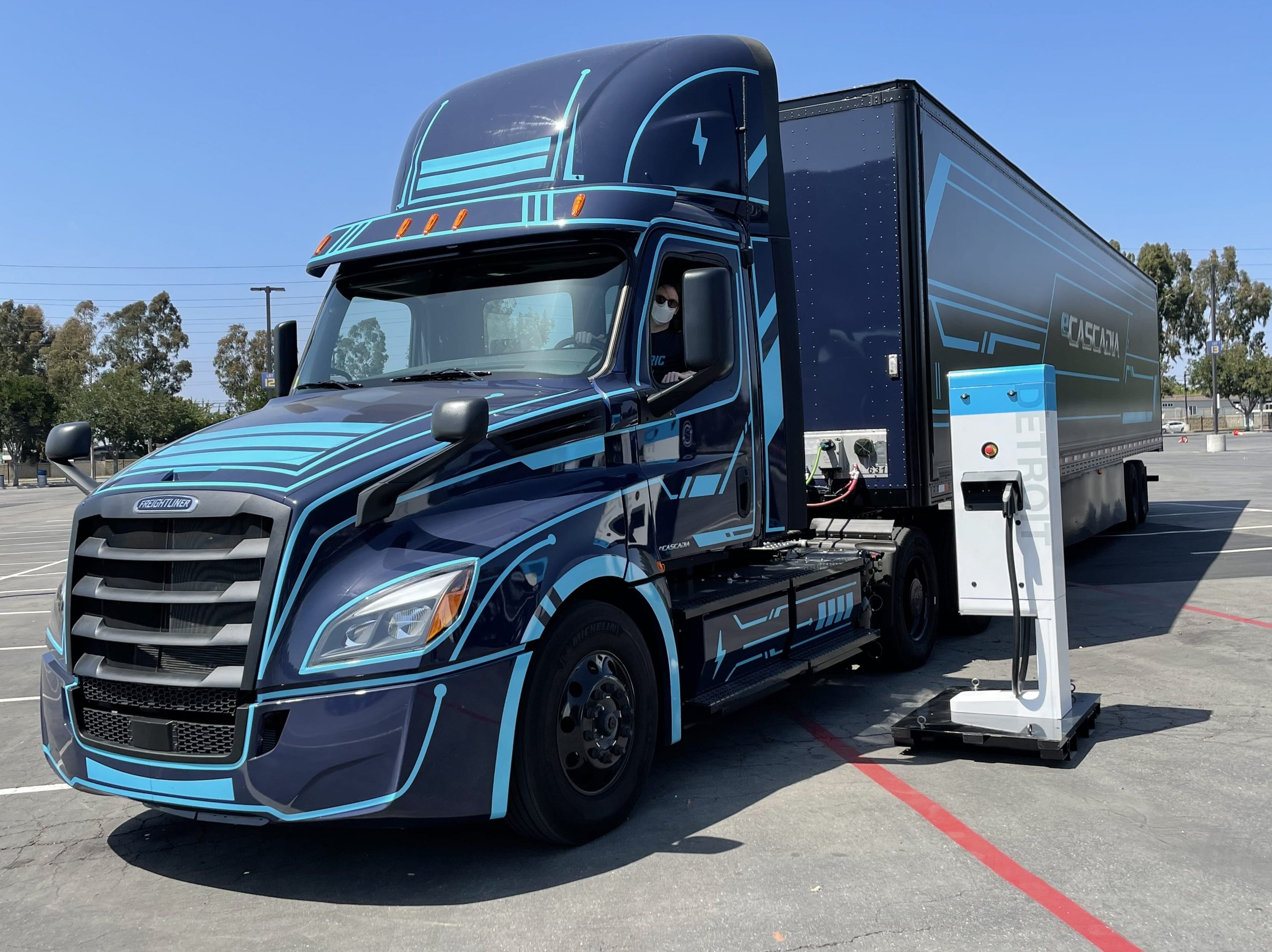
We drove it pretty close to fully loaded — the trailer was loaded up with concrete blocks to about 60,000lbs total weight.
Despite this weight, the truck still handled great. Admittedly, this was my first time driving a loaded semi-truck, so I don’t have much to compare with, but the truck did not feel labored under acceleration, and the braking was smooth and easy. Regenerative braking has three settings, and the strongest was very satisfying. It slowed the truck rapidly enough that the friction brakes would probably not be necessary in most driving situations.
This is great not just for maintenance purposes but also for air quality. While particulate pollution largely comes out of the tailpipes of fossil cars, brake dust also contributes to fine particulate pollution, and truck brakes, given how much weight they have to stop, contribute a disproportionate amount here. Going electric means reducing the amount of brake dust in the air, which will clean up the air and the roads.
Lower regenerative braking settings will be useful for when the truck is driving unloaded or without a trailer attached or for long downhill inclines. On long downhill stretches, trucks usually use engine braking to avoid brake fade, but this reduces fuel efficiency and can be very noisy. Regenerative braking, however, increases fuel efficiency and adds no noise.
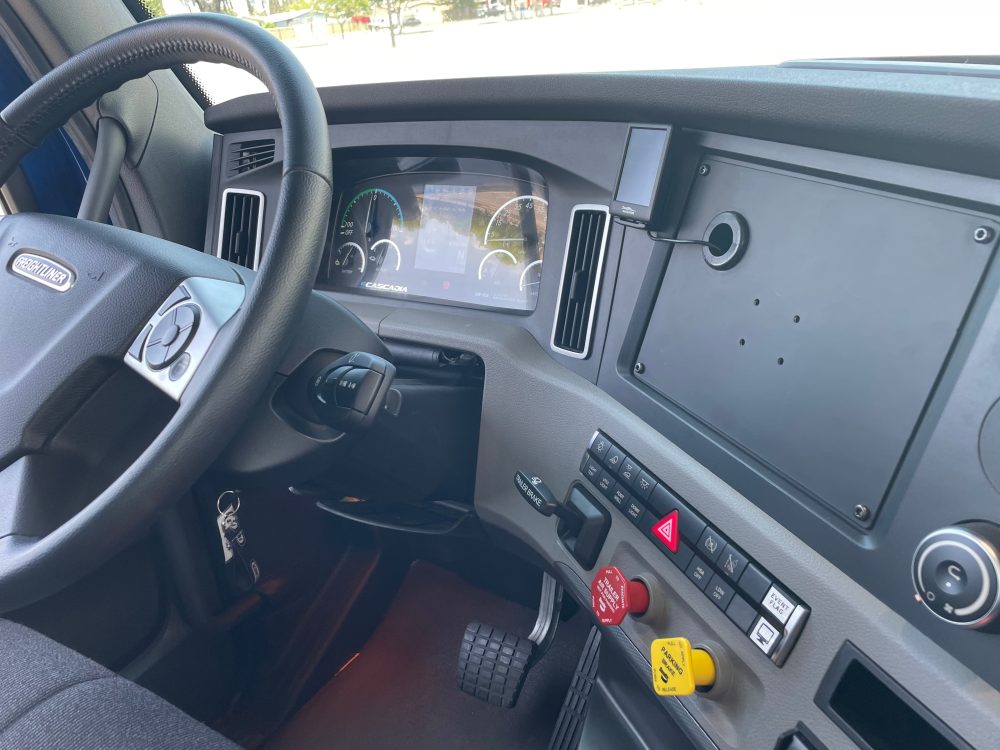
The interiors on both the eCascadia and eM2 are quite familiar rather than revolutionary. The standard utilitarian dashboard with lots of physical controls, comfortable seats, large windows with good visibility, etc.
Daimler has already started delivering some eCascadias to customers, so several have been on the road for the last couple of years already, with about 800,000 miles on the fleet so far. But these are mostly still being used on a trial basis, and the trucks aren’t widely available yet. Daimler plans to start large-scale deliveries in earnest in October 2022.
eM2 electric box truck first drive
Moving down to an unloaded eM2 box truck after driving the 60,000lb eCascadia was certainly a big contrast, despite the fact that both vehicles use Daimler’s proprietary Detroit ePowertrain (with different motor and battery configurations available between the two vehicles).
The eM2 obviously felt more nimble, but the amount of nimbleness was still incredible. It almost felt like driving a car, not a medium-duty truck.

It’s hard to make a comparison between the eM2 and the Volvo VNR, which we drove last year, since we drove one in a parking lot and the other on an actual racetrack. The eM2 does have a larger battery but is rated for lower peak horsepower — though, all of these things could change before production. Both offered impressive experiences and much more capability than we’d expect.
Customers will be able to limit the vehicle’s speed and acceleration if they so choose since some might not want their vehicles to be quite as zippy as the eM2 can be. Incidentally, just after the test drive event, I spoke with a former UPS manager, and his first reaction was, “I dunno if I’d want my drivers to have that much speed.”
Regenerative braking was a little less satisfying on the eM2 than the eCascadia. It’s adjustable, but even the strongest setting felt like it could be stronger, and it also felt a little jerky (though that could have been due to driver inexperience or the bouncy air ride seat). Daimler reps said they’re still tuning the system.
Like the eCascadia, some eM2s are already in service, but the truck is not widely available yet. The eM2 should be widely available starting April 2023.
Thomas Built “Jouley” electric school bus first drive
Moving onto the next two vehicles, we have a change in powertrain. For these earlier offerings, Daimler partnered with Proterra to provide batteries, drivetrain, and charging systems.
Both have a 226kWh battery pack good for about 130 miles of range, more than enough for most local school or delivery routes. Both charge in about three hours on a 60kW DC charger. They’re working on a 90kW charger to reduce charge times or to allow more vehicles to charge off of fewer chargers in the depot.
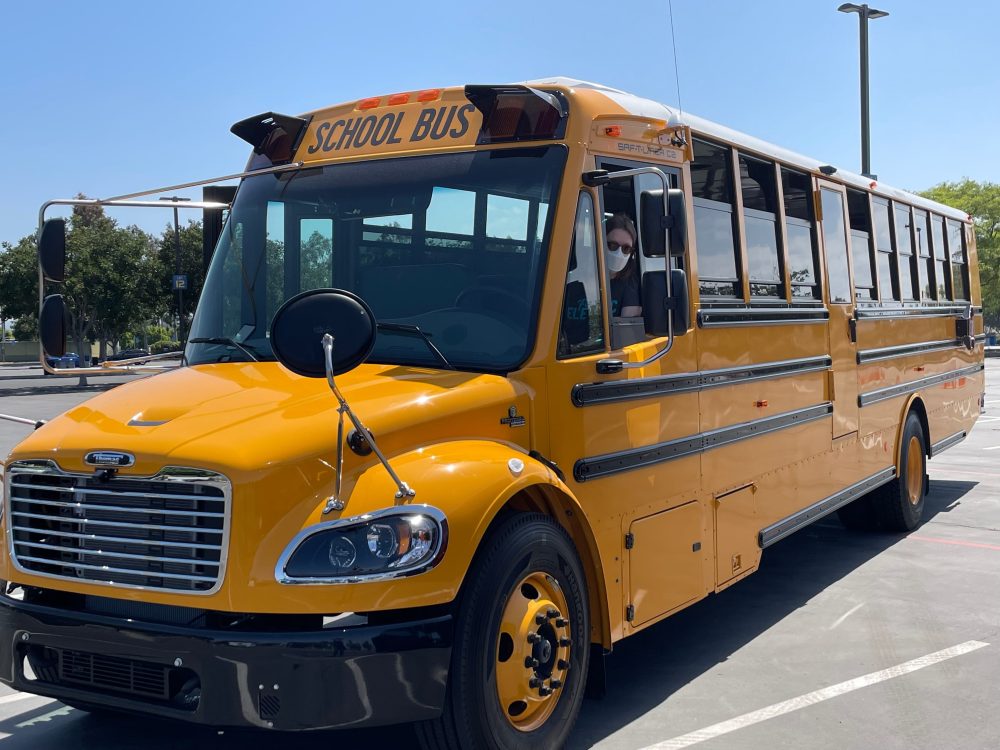
For the school bus, in particular, these usually have defined daily routes and spend several hours parked both during school and after school, which should make charging easy. Many school buses could probably even handle a standard level 2 charger or go a few days without charging if they have a short route.
Much like the other vehicles, the school bus had a nice smooth drive. Easy acceleration without grinding gears and belching exhaust, and a nice quiet ride as we expect from electric vehicles. All of them have embedded noisemakers for safety purposes (though not very audible in the video under the wind noise), which is particularly important for a school bus that could be around distracted children.
Daimler reps were sure to highlight all the safety features on the Jouley, including all-around cameras, which display on a display embedded in the center mirror, a Mobileye system for speed limit and follow distance alerts, and childminders to make sure that all kids have left the bus safely before the end of the route.
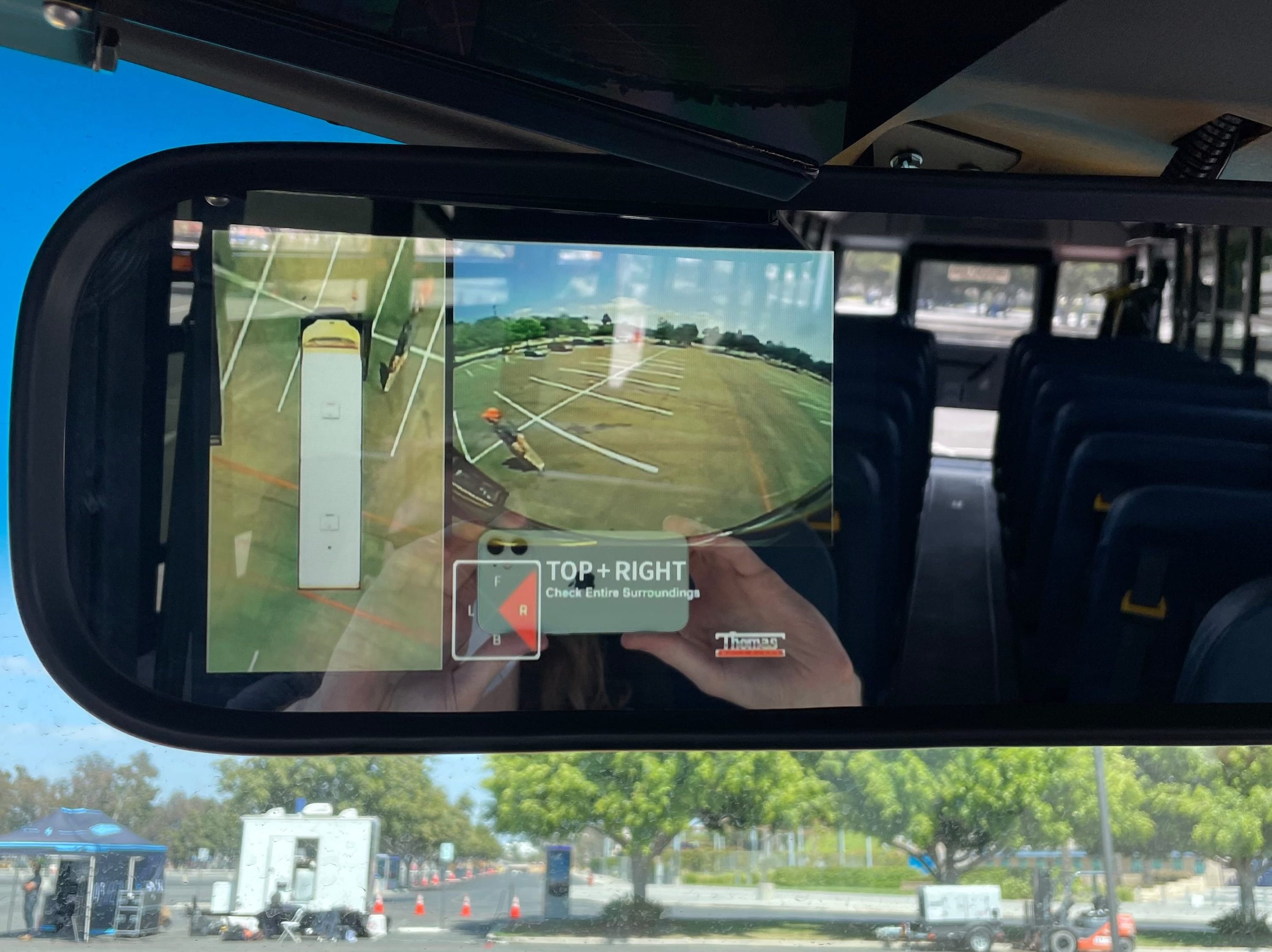
There are already about 50 Jouleys in service nationwide and many more on order, including the largest electric school bus order yet for 326 units over four years in Montgomery County in Maryland.
Freightliner Custom Chassis MT50e electric walk-in van first drive
In this case, the chassis is built by Freightliner, providing the battery, frame, drive system, and so on, while the body will be built by other companies that specialize in configuring delivery vehicles. These could be configured for bakery deliveries, parcels, food trucks, work vehicles for maintenance crews, etc.
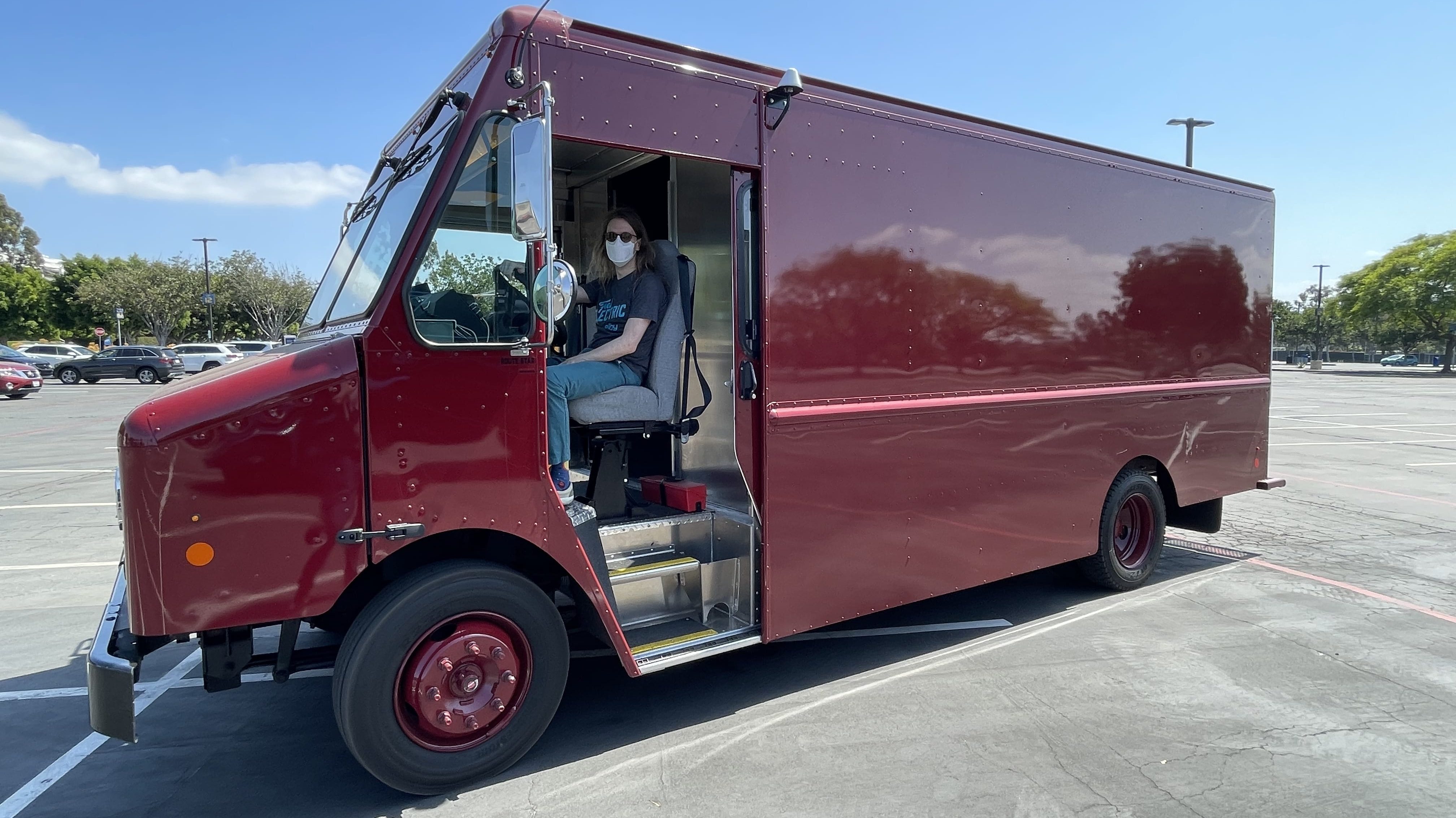
The truck has been designed with the battery between the frame rails underneath the body, which frees up space along the sides of the vehicles. These could be used for externally accessible storage, for example, for tool cases on maintenance vehicles.
The interior here was a little higher-tech than the others, at least in the form we saw it. The dash display is a large screen, with all-around overhead view and backup camera shown on the same display.
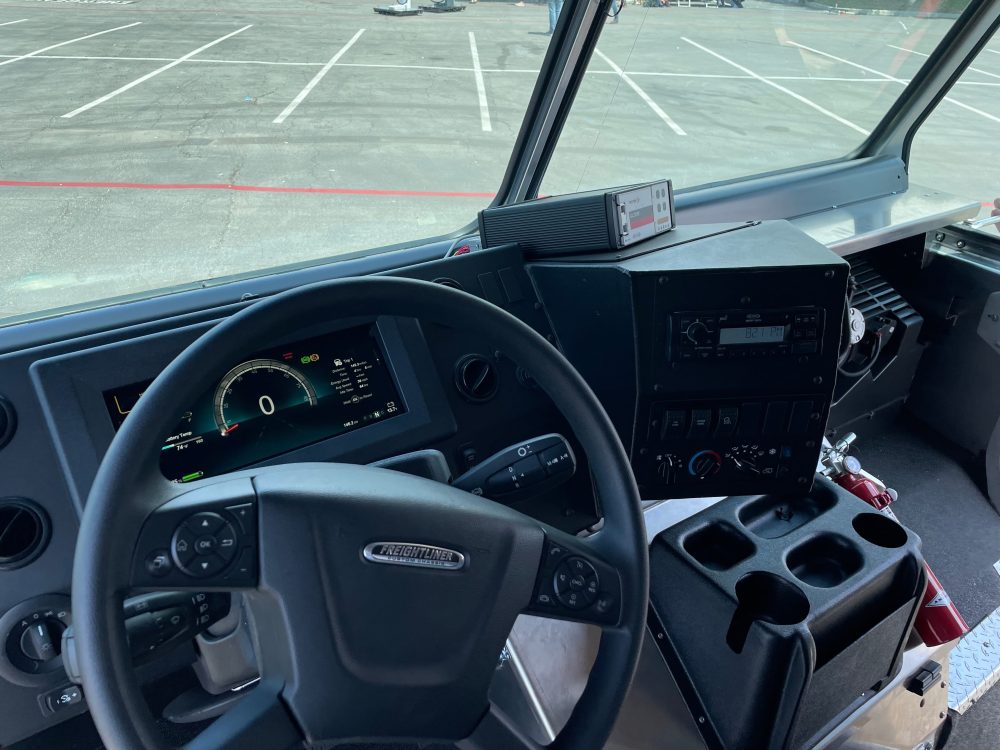
This one also had a little rougher ride than the other vehicles, and the van did rattle something fierce going across a bumpy parking lot. We expect that this would be less of an issue with a fully equipped and loaded van.
Production starts in earnest around January. UPS already has a contract for several trucks.
Charging considerations
Daimler also has products for charging, given that their vehicles will have heavy energy needs that oftentimes won’t be met by your standard level 2 charging system. Level 2 could be adequate for some applications like short school bus routes, but a semi-truck running back and forth from a port to a distribution center is going to need a lot more power.
All their vehicles come with a standard CCS plug and some kind of DC charging capability — ranging from the eCascadia at 240kW in its top configuration and the Jouley and MT50e charging at 60kW.
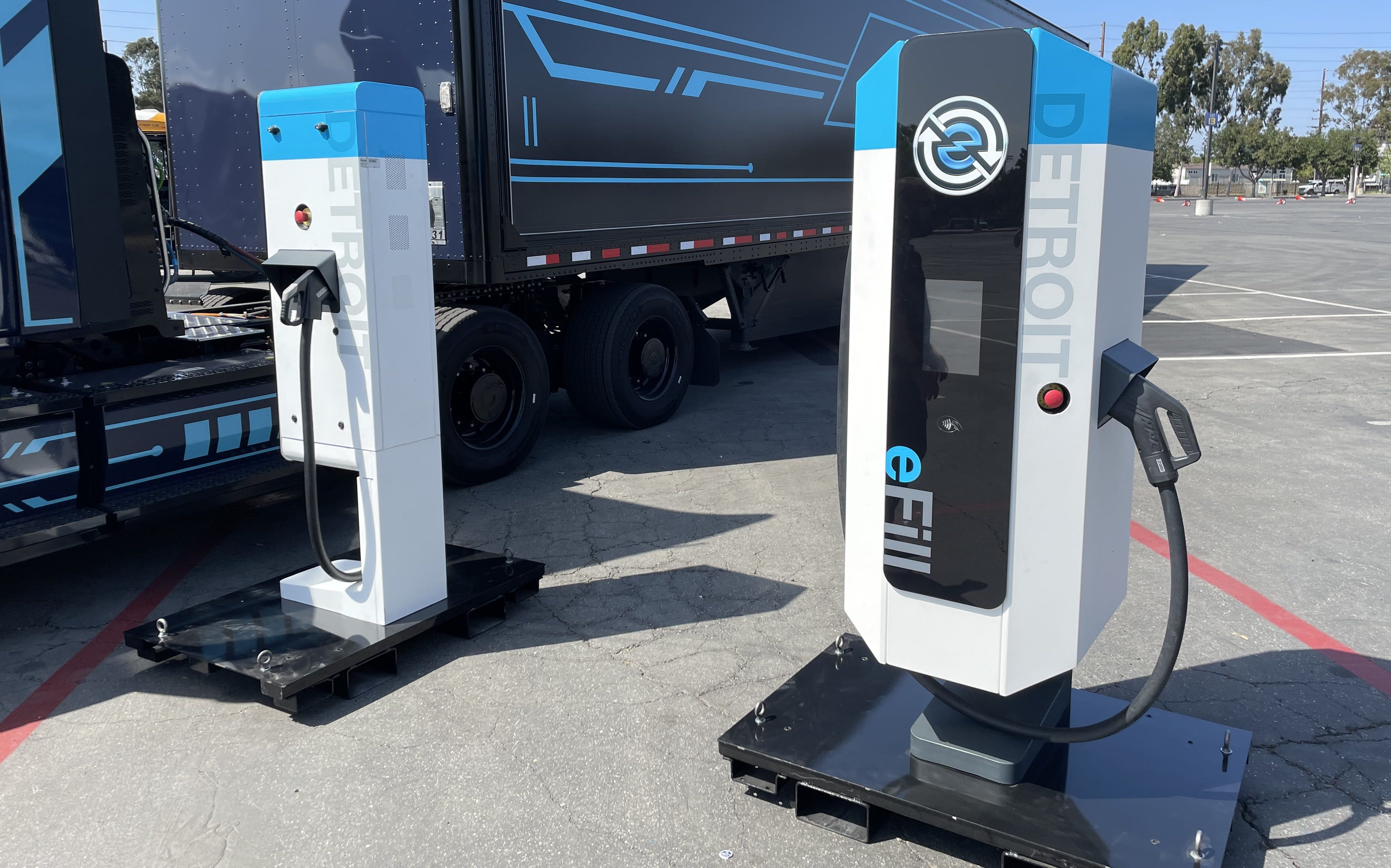
Daimler offers charging units at “competitive prices.” The eFill (on the right in the photo above) can be used as a stand-alone charger, wired directly into the grid, which can deliver 60kW of power (they’re working on a 120kW model). Or it can be paired with a charging cabinet (think of those large metal boxes hidden behind fences at Supercharger sites) for up to 400kW of power delivery. Even though none of their trucks currently can charge at 400kW, this will offer some degree of future-proofing for future vehicles that can utilize higher DC charging rates.
But Daimler doesn’t intend to stop there, as they are part of the CharIN group, which is currently developing a future standard for megawatt-plus charging capabilities. This “Megawatt Charging System” is still being standardized, with the hopes that it will provide enough juice for even the hungriest vehicles of the coming decades.
Faster charging would be a boon for long-haul trucking since stops could end up only taking minutes and also could enable more opportunity charging for other applications. It could save upfront cost, too, because extremely quick charging speeds could mean smaller batteries are necessary since charging will be so rapid.
Daimler, along with partner Portland General Electric, is already testing their vision for fast charging at what they have dubbed “electric island” in Portland, Oregon, where Daimler Trucks North America is headquartered and has its electric truck factory. The facility is built with drive-through charging spots that can fit heavy-duty vehicles and is open to the public as of last month. While megawatt chargers are not installed yet, the site plans to upgrade to them in the future, as well as adding on-site solar and energy storage.
Final thoughts on Daimler’s electric trucks
One takeaway was just how normal all of them felt. Many of the parts under the hood were similar (intentionally — to provide interchangeability for a lot of service parts), the buttons and switches and knobs were similar, the capabilities were similar. They were just a lot quieter, smoother, better-performing, and, best of all, lower polluting.
Since Daimler and Freightliner have spent so many years building trucks, amassing a ~40% market share in North America, they have a pretty good idea of what they’re doing. So these vehicles will be built with what truck drivers have come to expect, with the huge improvement of also being electrically powered. They should fit into fleets quite well, and as we’ve heard from drivers, they ought to love it when they get a chance to drive one.
As with the Volvo VNR, there are still a few things missing. Daimler didn’t specify prices, except to state that the initial price would be quite a bit higher than diesel models. They do highlight that the total cost of ownership will be lower due to reduced fuel and maintenance costs, which should be important for convincing fleet managers.
Another resistance point for customers is the myth that electric might not have enough power for heavy hauling. Daimler representatives told us that, despite that we’ve had fast and powerful electric cars out on the road for more than a decade now, there is still a sense among most of their customers that electric trucks won’t cut it. But, without exception, when prospective drivers are given time behind the wheel of one of Daimler’s electric trucks, those doubts disappear immediately. Any of our readers who have given or taken EV test drives have probably had the same experience.
Another potential benefit for convincing fleet managers and drivers is that the smoother ride experience is much less stressful, and therefore less tiring and damaging on the body of drivers. Daimler said some drivers have considered delaying retirement if they get to start driving electric trucks since it’s much easier on their bodies. And fleet managers are happy to hear this since the industry is currently experiencing a pretty severe driver shortage, and it’s unlikely many people will choose truck driver as a new career, particularly given that trucking jobs will likely start disappearing along with the development of automated drive systems.
All in all, it was nice to get a sense of the electric future for so many different medium- and heavy-duty vehicles all in one place. Despite being around a bunch of heavy machinery, it wasn’t smelly, or dirty, or noisy, and yet everything still had more than enough power to get their respective jobs done. Everything will be so much better when we transition society towards widespread use of these vehicles, and we can’t wait to see them everywhere.
FTC: We use income earning auto affiliate links. More.



Comments